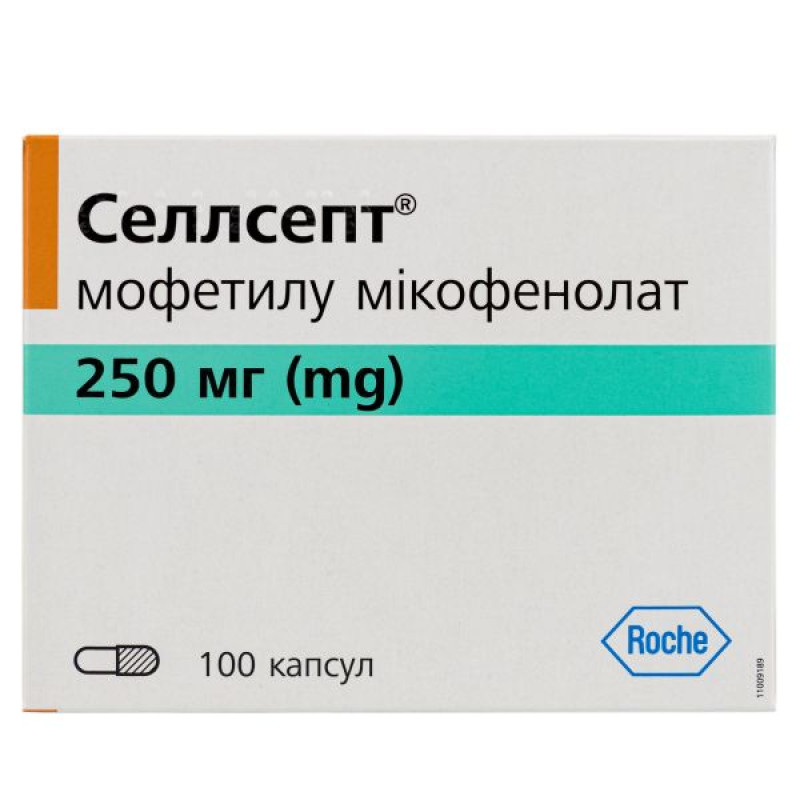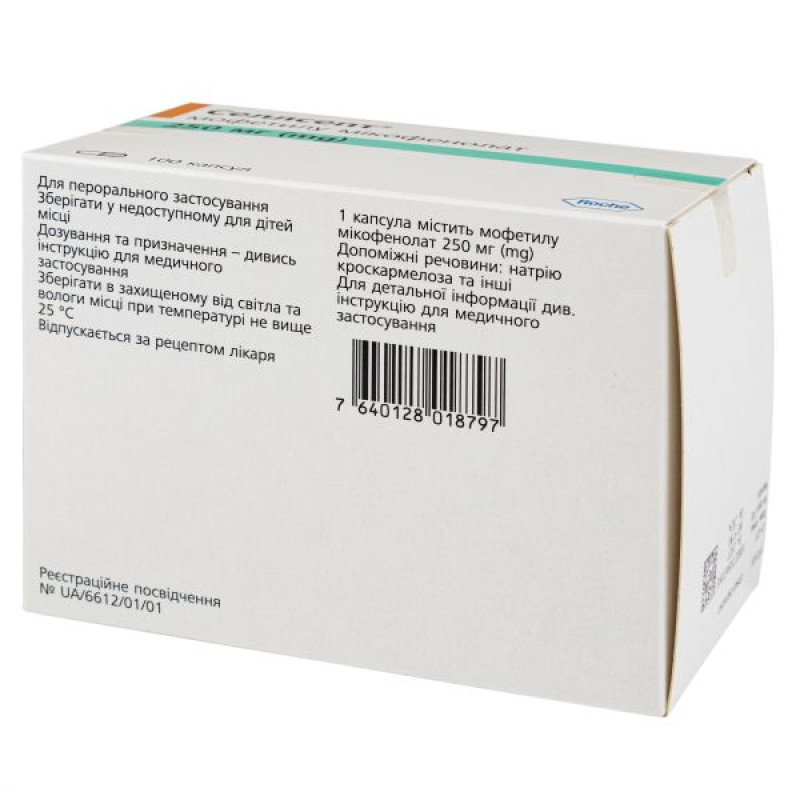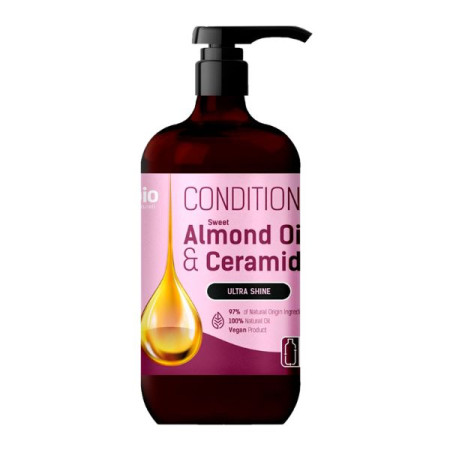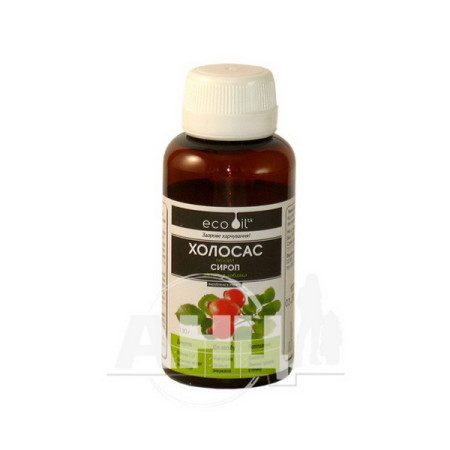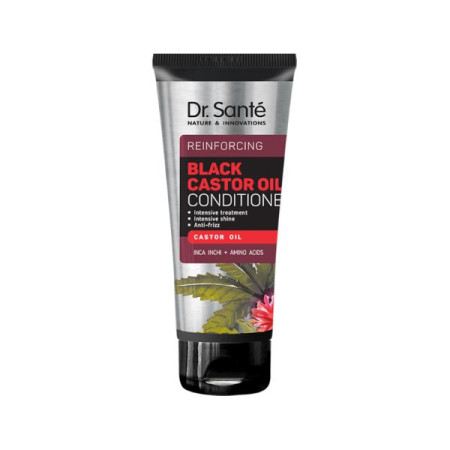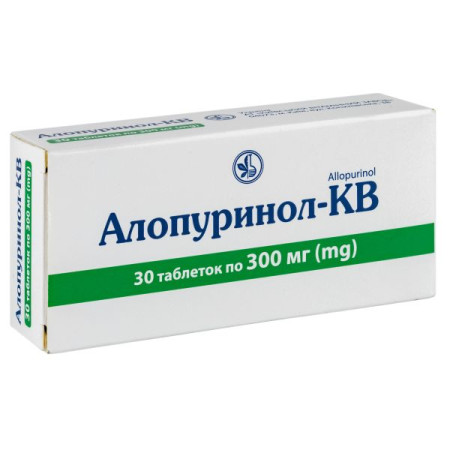Sellsept capsules 250 mg No. 100

Instructions for Cellcept capsules 250 mg No. 100
Composition
active ingredient: mycophenolic acid;
1 capsule contains mycophenolate mofetil 250 mg;
excipients: pregelatinized starch; croscarmellose sodium; povidone (K90); magnesium stearate; capsule shell: titanium dioxide (E 171); iron oxide yellow (E 172); iron oxide red (E 172); indigo carmine FD and C blue 2 (E 132); gelatin; printing ink.
Dosage form
Capsules.
Main physicochemical properties: hard gelatin capsules, opaque brown body, opaque blue cap; black marking: "CellCept 250" on cap and "Roche" on body; capsule contents: fine, partially clumped, white to off-white granular powder.
Pharmacotherapeutic group
Selective immunosuppressive drugs. Mycophenolic acid.
ATX code L04A A06.
Pharmacological properties
Pharmacodynamics.
Mechanism of action
Mycophenolate mofetil is the 2-morpholinoethyl ester of mycophenolic acid (MPA). Mycophenolic acid 2-morpholinoethyl ester is a potent, selective, non-competitive, and reversible inhibitor of inosine monophosphate dehydrogenase (IMPDH), which inhibits the de novo synthesis of guanosine nucleotides without incorporation into DNA. Mycophenolic acid 2-morpholinoethyl ester exerts a more pronounced cytostatic effect on lymphocytes than on other cells, since the proliferation of T and B lymphocytes is highly dependent on de novo purine synthesis, while other cell types can switch to alternative metabolic pathways.
Pharmacokinetics.
Absorption
Mycophenolate mofetil is rapidly and completely absorbed after oral administration and undergoes complete presystemic metabolism to form the active metabolite mycophenolic acid (MPA). Based on the suppression of acute renal transplant rejection, the immunosuppressive activity of CellCept® is correlated with the concentration of mycophenolic acid. The mean oral bioavailability of mycophenolate mofetil, as measured by AUCMPA (area under the concentration-time curve), is 94% of that after intravenous administration. Food intake does not affect the extent of absorption of mycophenolate mofetil (AUCMPA) when administered 1.5 g twice daily to renal transplant patients. However, the maximum concentration of mycophenolic acid is reduced by 40% when the drug is administered with food. After oral administration, plasma concentrations of mycophenolate mofetil are not determined.
Distribution
As a result of enterohepatic recirculation of the drug, a secondary increase in plasma concentrations of mycophenolic acid is usually observed approximately 6 to 12 hours after administration. When co-administered with cholestyramine (4 g 3 times a day), the AUC of MPA is reduced by approximately 40%, indicating a significant degree of enterohepatic recirculation.
At clinically relevant concentrations, mycophenolic acid is 97% bound to plasma albumin.
Metabolism
Mycophenolic acid is metabolized primarily by glucuronyltransferase (UGT1A9 isoform) to form the inactive phenolic glucuronide of mycophenolic acid. In vivo, the phenolic glucuronide of mycophenolic acid is converted back to free mycophenolic acid by enterohepatic recirculation. A lower acyl glucuronide (AcMPAG) is also formed, which is pharmacologically active and may be responsible for some of the side effects of mycophenolate mofetil (diarrhea, leukopenia).
Breeding
Minor amounts of the drug (< 1% of the dose) are excreted in the urine as mycophenolic acid. After oral administration of radiolabeled mycophenolate mofetil, 93% of the administered dose is excreted in the urine and 6% in the feces. A significant portion (approximately 87%) of the administered dose is excreted in the urine as the phenolic glucuronide of mycophenolic acid.
Mycophenolic acid and mycophenolic acid phenolic glucuronide are not removed by haemodialysis at clinically relevant concentrations. However, at higher concentrations of mycophenolic acid phenolic glucuronide (> 100 µg/ml), a small amount may be removed.
By disrupting the enterohepatic recirculation of CellCept®, bile acid sequestrants such as cholestyramine reduce AUCMPC (see section “Overdose”).
In the early post-transplant period (up to 40 days after kidney, heart or liver transplantation), the mean AUC values of MPA were approximately 30% lower and the maximum concentrations were approximately 40% lower than in the late post-transplant period (3-6 months after transplantation).
Special patient groups.
Patients with renal insufficiency
In a single-dose study (6 patients per group), the mean AUC of MPA in plasma was 28-75% higher in patients with severe chronic renal failure (glomerular filtration rate < 25 mL/min/1.73 m2) than in healthy volunteers and patients with less severe renal impairment. However, after a single dose, the mean AUC of mycophenolic acid phenolic glucuronide was 3-6 times higher in patients with severe renal failure than in patients with mild renal failure and healthy volunteers, which is consistent with known data on the renal excretion of mycophenolic acid phenolic glucuronide. Multiple-dose studies of mycophenolate mofetil in severe renal failure have not been conducted. There are no data in patients with severe chronic renal failure after heart and liver transplantation.
Delayed kidney transplant function
In patients with delayed renal graft function after transplantation, the mean AUC0-12 for mycophenolic acid was comparable to that in patients with immediate graft function. The mean AUC0-12 for the phenolic glucuronide of mycophenolic acid in plasma was 2- to 3-fold higher than in patients with immediate graft function. Transient increases in the free fraction and plasma concentrations of mycophenolic acid may occur in patients with delayed renal graft function. No dose adjustment of CellCept® is required in such cases.
Patients with hepatic insufficiency
In volunteers with alcoholic cirrhosis, it was found that liver parenchymal damage had relatively no effect on the glucuronidation of mycophenolic acid. The effect of liver disease on this process depends on the specific disease. However, in liver disease with a predominance of biliary tract involvement (e.g., primary biliary cirrhosis), the effect may be different.
Children
Pharmacokinetic parameters were studied in 49 pediatric renal transplant patients (aged 2 to 18 years) who received mycophenolate mofetil 600 mg/m2 orally twice daily. At this dose, the AUCMPC was similar to that in adult renal transplant patients who received CellCept 1 g twice daily in the early and late post-transplant periods. The AUCMPC values in different age groups were comparable in the early and late post-transplant periods.
Elderly patients
The pharmacokinetics of mycophenolate mofetil and its metabolites have not been shown to be altered in elderly patients (≥ 65 years) compared to younger transplant patients.
Patients taking oral contraceptives
Mycophenolate mofetil does not affect the pharmacokinetics of oral contraceptives (see section 4.5).
When co-administered with combined oral contraceptives containing ethinylestradiol (0.02-0.04 mg) and levonorgestrel (0.05-0.15 mg), desogestrel (0.15 mg) or gestodene (0.05-0.1 mg), Cellcept® (1 g twice daily) in a study of 18 post-transplant women not receiving other immunosuppressants had no clinically significant effect on the suppression of ovulation by oral contraceptives. Progesterone, luteinizing hormone and follicle-stimulating hormone levels were not significantly altered.
Indication
Prevention of acute organ rejection in patients after allogeneic kidney, heart, or liver transplantation as part of combination therapy with cyclosporine and corticosteroids.
Contraindication
CellCept® should not be used in patients with hypersensitivity to mycophenolate mofetil, mycophenolic acid or any of the other ingredients of the product. Cases of hypersensitivity reactions have been observed with CellCept® (see section 4.8).
CellCept® should not be used in women of childbearing potential not using highly effective contraception (see section “Use during pregnancy or breast-feeding”).
CellCept® treatment should not be initiated in women of childbearing potential without obtaining the results of a pregnancy test to rule out unintended use during pregnancy (see section “Use during pregnancy or lactation”).
CellCept® should not be used in pregnant women unless there is no suitable alternative treatment to prevent transplant rejection (see section “Use during pregnancy or breast-feeding”).
Cellcept® should not be used by women who are breastfeeding (see section “Use during pregnancy or breastfeeding”).
Because mycophenolate mofetil has been shown to be teratogenic in animal studies, CellCept® capsules should not be opened or crushed. Avoid inhalation of the powder contained in CellCept® capsules or direct contact with skin or mucous membranes. If this occurs, wash the affected area thoroughly with soap and water, and eyes with water only.
Interaction with other medicinal products and other types of interactions
Acyclovir.
When mycophenolate mofetil was administered with acyclovir, higher plasma concentrations of acyclovir were observed than when acyclovir was administered alone. Changes in the pharmacokinetics of mycophenolic acid phenolic glucuronide (an 8% increase for mycophenolic acid phenolic glucuronide) were minimal and not considered clinically significant. Since plasma concentrations of mycophenolic acid phenolic glucuronide, like acyclovir, are increased in renal failure, it is possible that mycophenolate mofetil and acyclovir or its prodrugs, such as valaciclovir, compete for tubular secretion and further increase the concentrations of both drugs.
Antacids and proton pump inhibitors.
Co-administration of CellCept® with antacids (aluminum and magnesium hydroxide) and proton pump inhibitors, including lansoprazole and pantoprazole, resulted in a decrease in mycophenolic acid exposure. There was no significant difference in the incidence of graft rejection between patients receiving CellCept® and proton pump inhibitors and patients receiving CellCept® and not receiving proton pump inhibitors. This result allows for extrapolation of these data to all antacids, as the decrease in exposure with concomitant administration of CellCept® with magnesium and aluminum hydroxides was significantly less than with concomitant administration of CellCept® with proton pump inhibitors.
Drugs that affect enterohepatic recirculation (e.g. cholestyramine, cyclosporine A, antibiotics).
Caution should be exercised when co-administering mycophenolate mofetil with drugs that affect enterohepatic recirculation, as they may reduce the efficacy of CellCept®.
Cholestyramine.
After administration of a single dose of 1.5 g of mycophenolate mofetil to healthy volunteers who had previously received 4 g of cholestyramine 3 times a day for 4 days, a 40% decrease in AUC of MPA was observed (see sections 4.4 and 5.2). Caution should be exercised when mycophenolate mofetil and cholestyramine are administered concomitantly due to the potential for decreased efficacy of CellCept®.
Cyclosporine A.
Mycophenolate mofetil does not affect the pharmacokinetics of cyclosporine A. If concomitant cyclosporine is discontinued, an increase in the area under the concentration-time curve of approximately 30% can be expected. Cyclosporine A affects enterohepatic recirculation, resulting in a 30-50% decrease in mycophenolic acid exposure in renal transplant patients treated with CellCept and cyclosporine A compared to patients treated with sirolimus or belatacept and similar doses of CellCept (see sections 4.4). Conversely, changes in mycophenolic acid exposure should be expected when patients are switched from cyclosporine A to an immunosuppressant that does not affect enterohepatic recirculation.
Antibiotics that reduce the number of β-glucuronidase-producing bacteria in the gut (e.g. aminoglycosides, cephalosporins, fluoroquinolones and penicillins) may affect the enterohepatic circulation of MPAG (mycophenolic acid glucuronide)/MPA, which may lead to a decrease in systemic MPA exposure. Information is available for the following antibiotics:
Ciprofloxacin or amoxicillin with clavulanic acid.
A decrease in trough (mycophenolic acid) concentrations of approximately 50% was observed in renal transplant patients within a few days immediately following oral administration of ciprofloxacin or amoxicillin/clavulanic acid. This effect tended to decrease with continued antibiotic therapy and disappeared after discontinuation of antibiotic therapy. Changes in trough levels of mycophenolic acid may not accurately reflect changes in total exposure to mycophenolic acid. Therefore, dose adjustment of CellCept® is not usually necessary due to the lack of clinical data on graft dysfunction. However, close clinical monitoring is necessary during combination therapy and immediately after discontinuation of antibiotic therapy.
Norfloxacin and metronidazole.
In healthy volunteers, no significant interaction was observed when CellCept® was administered concomitantly with either of these antibacterial agents. However, concomitant administration of CellCept® with norfloxacin and metronidazole reduced mycophenolic acid exposure by approximately 30% following a single dose of CellCept®.
Trimethoprim/sulfamethoxazole.
No effect on the bioavailability of mycophenolic acid was observed.
Concomitant use of medicinal products that affect MPA glucuronidation may alter MPA exposure. Therefore, caution is recommended when these medicinal products are used concomitantly with CellCept®.
Isavuconazole.
A 35% increase in MPA AUC0-∞ was observed during co-administration with isavuconazole.
Telmisartan.
Concomitant administration of telmisartan and CellCept® resulted in a decrease in mycophenolic acid concentrations by approximately 30%. Telmisartan alters the clearance of mycophenolic acid by upregulating the expression of peroxisome proliferator-activated receptor gamma (PPAR gamma), which in turn upregulates the expression and activity of uridine diphosphate glucuronyltransferase 1A1 (UGT1A9). When comparing the incidence of transplant rejection or adverse reaction profile in patients receiving CellCept® with or without concomitant telmisartan, no clinical consequences of the pharmacokinetic interaction between these drugs were observed.
Ganciclovir.
Based on the results of a study with a single oral dose of recommended doses of mycophenolate mofetil and intravenous ganciclovir, taking into account the known effect of renal insufficiency on the pharmacokinetics of CellCept® (see section “Dosage and Administration”) and ganciclovir, it can be assumed that the simultaneous use of these drugs (which compete for tubular secretion mechanisms) will lead to an increase in the concentrations of the phenolic glucuronide of mycophenolic acid and ganciclovir. No significant change in the pharmacokinetics of mycophenolic acid is expected, therefore, no dose adjustment of CellCept® is required. If CellCept® and ganciclovir or its prodrugs, such as valganciclovir, are prescribed simultaneously in patients with renal insufficiency, the recommended dosage regimen for ganciclovir should be followed and the patients should be carefully monitored.
Oral contraceptives.
Cellcept® does not affect the pharmacokinetics and pharmacodynamics of oral contraceptives when used concomitantly (see section "Pharmacokinetics").
Rifampicin.
In patients not taking cyclosporine, concomitant use of CellCept® and rifampicin was associated with a decrease in mycophenolic acid exposure of 18% to 70% (AUC0-12h). Monitoring of mycophenolic acid exposure and dose adjustment of CellCept® are recommended to maintain clinical benefit during concomitant use.
Sevelamer.
A decrease in Cmax and AUC(0-12 g) of mycophenolic acid by 30% and 25%, respectively, was observed when CellCept® was co-administered with sevelamer without any clinical consequences (i.e., without graft rejection). However, to minimize the effect of sevelamer on the absorption of mycophenolic acid, it is recommended that CellCept® be administered at least 1 hour before or 3 hours after sevelamer. There are no data on the use of CellCept® with phosphate binders other than sevelamer.
Tacrolimus.
Concomitant administration of tacrolimus and CellCept® had no significant effect on the AUC and Cmax of mycophenolic acid, the active metabolite of CellCept®, in liver transplant patients. In liver transplant patients, the AUC of tacrolimus increased by approximately 20% after multiple doses of CellCept® 1.5 g twice daily. However, in renal transplant patients, CellCept® had no effect on tacrolimus concentrations (see section 4.4).
Live vaccines.
Live vaccines should not be administered to patients with compromised immune response. Antibody production in response to other vaccines may be reduced (see section 4.4).
Children.
Interaction studies have only been conducted in adults.
Potential interactions.
Concomitant administration of probenecid and mycophenolate mofetil in monkeys was associated with a 3-fold increase in the plasma AUC of mycophenolic acid phenolic glucuronide. Thus, other drugs that undergo renal tubular secretion may compete with mycophenolic acid phenolic glucuronide, leading to increased plasma concentrations of mycophenolic acid phenolic glucuronide or other drugs that also undergo tubular secretion.
Application features
Neoplasm
Patients receiving immunosuppressive therapy, including combination therapy, including CellCept®, are at increased risk of developing lymphomas and other malignancies, particularly of the skin (see section 4.8). This risk is apparently not related to the use of any drug per se, but to the intensity and duration of immunosuppression. To minimize the risk of skin cancer, exposure to sunlight and ultraviolet radiation should be limited by wearing appropriate protective clothing and using sunscreen with a high SPF.
Patients receiving immunosuppressive therapy, including CellCept®, are at increased risk of opportunistic infections (bacterial, fungal, viral and protozoal), fatal infections and sepsis (see section 4.8). These infections include reactivation of latent viral infections such as hepatitis B or hepatitis C reactivation and infections caused by polyomaviruses (VK virus-associated nephropathy, JC virus-associated progressive multifocal leukoencephalopathy). Cases of hepatitis B or hepatitis C reactivation have been reported in carriers receiving immunosuppressive therapy. These infections are often associated with a high overall immunosuppressive burden and can lead to serious or fatal outcomes, which the physician should consider in the differential diagnosis of immunosuppressed patients with impaired renal function or neurological symptoms.
Cases of hypogammaglobulinemia associated with recurrent infections have been reported in patients receiving CellCept® in combination with other immunosuppressants. In some of these cases, switching patients from CellCept® to an alternative immunosuppressant resulted in a return of serum IgG levels to normal. Serum immunoglobulin levels should be measured in patients receiving CellCept® who develop recurrent infections. In cases of persistent, clinically significant hypogammaglobulinemia, appropriate clinical management should be considered, taking into account the potential cytostatic effects of mycophenolic acid on T- and B-lymphocytes.
Bronchiectasis has been reported in adults and children receiving CellCept® in combination with other immunosuppressants. In some of these cases, switching patients from CellCept® to another immunosuppressant resulted in improvement in respiratory symptoms. The risk of bronchiectasis may be related to hypogammaglobulinemia or to direct pulmonary effects. There have also been isolated reports of interstitial lung disease and pulmonary fibrosis, some of which were fatal (see section 4.8). Patients who develop persistent pulmonary symptoms such as cough and dyspnea are advised to seek medical advice.
Blood and lymphatic system
Patients receiving CellCept® should be monitored for neutropenia, which may be related to CellCept® therapy itself, concomitant medications, viral infections, or a combination of these factors. Complete blood counts should be performed weekly during the first month of treatment, twice monthly during the second and third months of treatment, and monthly thereafter for the first year. If neutropenia (absolute neutrophil count < 1300/μL) develops, CellCept® should be interrupted or discontinued.
Cases of pure red cell aplasia have been reported in patients treated with CellCept® in combination with other immunosuppressants. The mechanism of pure red cell aplasia with mycophenolate mofetil is unknown. Pure red cell aplasia may be reversible upon dose reduction or discontinuation of CellCept®. Changes in CellCept® therapy should only be made with appropriate monitoring of patients after transplantation to minimize the risk of graft rejection (see section 4.8).
Patients taking CellCept® should be advised to immediately report any signs of infection, hematoma, bleeding, or other signs of bone marrow failure to their physician.
Patients should be informed that vaccination may be less effective during treatment with CellCept® and that the use of live attenuated vaccines should be avoided (see section 4.5). Physicians should follow national recommendations for influenza vaccination.
Gastrointestinal tract
Since the use of CellCept® has been associated with an increased risk of gastrointestinal adverse reactions, including infrequent cases of gastrointestinal ulceration, gastrointestinal bleeding, and gastrointestinal perforation, CellCept® should be used with caution in patients with active serious gastrointestinal diseases.
CellCept® is an inhibitor of inosine monophosphate dehydrogenase. Therefore, CellCept® should be avoided in patients with rare hereditary deficiencies of hypoxanthine-guanine phosphoribosyltransferase, such as Lesch-Nyen and Kelley-Siegmiller syndromes.
Caution should be exercised when switching a patient from combination therapy containing immunosuppressants that affect the enterohepatic recirculation of mycophenolic acid, such as ciclosporin, to other drugs that do not affect the enterohepatic recirculation of mycophenolic acid, such as tacrolimus, sirolimus, belatacept, or vice versa, as this may lead to changes in mycophenolic acid exposure. Drugs that affect the enterohepatic recirculation of mycophenolic acid (e.g. cholestyramine, antibiotics) should be used with caution due to their potential to reduce the plasma levels and efficacy of CellCept® (see section 4.5). Therapeutic monitoring of mycophenolic acid may be appropriate when changing combination therapy (e.g. from ciclosporin to tacrolimus or vice versa) or to ensure appropriate immunosuppression in patients at high immunological risk (e.g. risk of rejection, treatment with antibiotics, addition or withdrawal of an interacting drug).
It is not recommended to prescribe Cellcept® simultaneously with azathioprine, as their simultaneous use has not been studied.
The risk/benefit balance of mycophenolate mofetil in combination with tacrolimus or sirolimus has not been established (see section 4.5).
Special patient groups
Elderly patients may be at increased risk of adverse events, including some infections (including tissue-invasive cytomegalovirus infection) and possibly gastrointestinal bleeding and pulmonary edema, compared with younger patients (see section 4.8).
Teratogenic effect
Mycophenolate is a potent human teratogen. Spontaneous abortion (45-49%) and congenital malformations (estimated at 23-27%) have been reported following exposure to mycophenolate mofetil during pregnancy. Therefore, CellCept® is contraindicated during pregnancy unless there is no suitable alternative treatment to prevent transplant rejection. Women and men of childbearing potential should be informed of the risks and the need to follow the recommendations outlined in the section “Use during pregnancy or lactation” (e.g., contraceptive methods, pregnancy tests) before, during, and after therapy with CellCept®. Physicians should ensure that women and men taking mycophenolate understand the risk of harm to the fetus, the need to use effective contraception, and the need to consult a physician immediately if there is a possibility of pregnancy.
Contraception (see section “Use during pregnancy or breastfeeding”)
Clear clinical evidence indicates a high risk of miscarriage and birth defects when mycophenolate mofetil is used during pregnancy, therefore, every effort should be made to avoid pregnancy during treatment with CellCept®, therefore, women of childbearing potential should use at least one reliable method of contraception or two reliable methods of contraception simultaneously before starting treatment with CellCept®, during treatment and for six weeks after stopping treatment if abstinence is not the chosen method of contraception. To minimize the likelihood of contraceptive failure and unintended pregnancy, the simultaneous use of two complementary methods of contraception is preferred.
Additional precautions
Patients should not donate blood during therapy and for at least 6 weeks after stopping mycophenolate. Men should not donate sperm during therapy and for 90 days after stopping mycophenolate.
Excipients with known effect: This medicine contains less than 1 mmol sodium (23 mg) per dose.
Disposal of unused and expired medicinal products: Release of medicinal products into the environment should be minimised. The medicinal product should not be disposed of via wastewater or household waste. For disposal, use a so-called “waste collection system” if available.
Use during pregnancy or breastfeeding
Women of reproductive age
Pregnancy should be avoided during treatment with mycophenolate mofetil. Therefore, women of childbearing potential should use at least one reliable method of contraception before starting treatment with CellCept®, during treatment, and for six weeks after stopping treatment if abstinence is not the chosen method of contraception. The simultaneous use of two complementary methods of contraception is preferred.
Pregnancy
The use of CellCept® is contraindicated during pregnancy unless there is no suitable alternative treatment to prevent transplant rejection.
Women and men of reproductive age should be informed at the beginning of treatment about the increased risk of fetal loss during pregnancy and congenital malformations, as well as advised on pregnancy prevention and planning.
Before starting treatment with CellCept®, women of childbearing potential should have two negative urine or serum pregnancy tests with a sensitivity of at least 25 mIU/mL to exclude unintended fetal exposure to mycophenolate mofetil. Two serum or urine pregnancy tests with a sensitivity of at least 25 mIU/mL are recommended; the second test is recommended 8 to 10 days after the first test and immediately prior to starting mycophenolate mofetil. In deceased donor transplants, if it is not possible to perform two tests 8 to 10 days apart prior to starting treatment (due to uncertainty about the time frame in which an organ will be available for transplantation), a pregnancy test should be performed immediately prior to starting treatment and a second test 8 to 10 days later.
Pregnancy tests should be repeated if clinically indicated (e.g., after a contraceptive interruption is reported). The results of all pregnancy tests should be discussed with the patient. Patients should be instructed to consult a physician immediately upon pregnancy.
Mycophenolate is a potent human teratogen and is associated with an increased risk of spontaneous abortion and congenital malformations when exposed during pregnancy:
Spontaneous abortions occurred in 45-49% of pregnant women treated with mycophenolate mofetil, compared with a reported incidence of 12-33% in solid organ transplant patients treated with immunosuppressants other than mycophenolate mofetil.
· According to the scientific literature, birth defects were observed in 23-27% of live births of children whose mothers received mycophenolate mofetil during pregnancy (compared to 2-3% of live births in the general population and approximately 4-5% of live births of children whose mothers received immunosuppressants other than mycophenolate mofetil after solid organ transplantation).
Congenital malformations, including reports of multiple birth defects, have been observed in the post-marketing period in children of patients who received CellCept® in combination with other immunosuppressants during pregnancy. The most frequently reported congenital malformations were:
· ear anomalies (e.g., abnormally formed or absent external/middle ear), atresia of the external auditory canal;
· congenital heart disease, for example, atrial and ventricular septal defects;
· congenital facial deformity, such as cleft lip, cleft palate, micrognathia, and orbital hypertelorism;
Eye abnormalities (e.g. coloboma);
Congenital finger defects (e.g. polydactyly, syndactyly);
Tracheoesophageal birth defects (e.g. esophageal atresia);
· congenital defects of the nervous system, such as non-union of the vertebral arches;
· kidney abnormalities.
In addition, isolated reports of the following birth defects have been received:
· microphthalmia;
· congenital choroid plexus cyst;
· agenesis of the transparent septum;
· olfactory nerve agenesis.
Animal studies have shown reproductive toxicity.
Breast-feeding
Mycophenolate mofetil is excreted in the milk of lactating rats. It is not known whether this active substance is excreted in human milk. Because of the potential for serious adverse reactions in nursing infants from mycophenolate mofetil, CellCept® is contraindicated during breastfeeding (see section 4.3).
Men
Limited clinical data do not indicate an increased risk of birth defects or miscarriage if the father is exposed to mycophenolate mofetil.
MPA is a potent teratogen. It is not known whether MPA is present in semen. Calculations based on animal data suggest that the maximum amount of MPA that could potentially be transferred to a woman is so small that an effect is unlikely. Animal studies have shown that mycophenolate mofetil is genotoxic at concentrations slightly in excess of human therapeutic exposures, so the risk of genotoxic effects on sperm cells cannot be completely excluded.
Therefore, the following precautions are recommended: sexually active male patients or their partners
There are no reviews for this product.
There are no reviews for this product, be the first to leave your review.
No questions about this product, be the first and ask your question.




